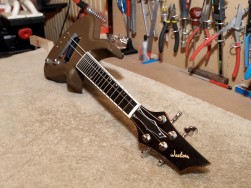Guitar repair and fabrication services in Ottawa

Please visit our contact page for information on how to book your visit.
Welcome to Weston Instruments, a guitar repair centre in Ottawa, Ontario. A place where neglected, old, worn and broken instruments find a new life thanks to Ian Weston, Luthier. Ian was schooled at the Totnes School of Guitarmaking in England, apprenticed for 4 years at Luthierie MF in Montreal, and pursues ongoing education in the field. Weston Instruments is also equipped with one of only three Plek machines in Canada, and is a memeber of the Plek service, support and R&D team. The shop is a service centre for both C.F. Martin, Santa Cruz and Taylor Guitars.
With over 10 000 repairs and over 25 builds of experience, I can fix, modify, setup, tune up or build your treasured instrument. You can read my resume in the About section of this website, or read what others have to say on the testimonials page. We also have a very active facebook page. In the world of guitars and basses, its the smallest adjustments that make the hugest difference. And when it comes to years of use, I can make your treasured guitar new again. With a healthy blend of art and science, I can give your musical instrument a life you might have never discovered.
FOLLOW THE FACEBOOK PAGE TO SEE WHAT'S GOING ON IN THE SHOP! YOU WILL FIND HUNDREDS OF PHOTOS AND DESCRIPTIONS OF PAST AND CURRENT WORK.
Have fun perusing through the website. There are a bunch of articles about the science behind guitars, old patents, univeristy reasearch papers and more in the Article and Blog section.
Weston Instruments services guitars, basses, mandolins, banjos, bouzoukis and many other instruments in the Ottawa, Kanata, Ashton, Stitsville, Richmond, Almonte and Carleton place region.


As for major repairs, these things can happen. Headstocks break, tops can split, braces come unglued, frets get worn out. Whatever you need for a major repair, or modification, bring me your guitar and I will make it sing again.
 My philosophy: Every pre-fabricated guitar, bass, mandolin, bouzouki or other instrument is a wonderful base that needs to be adapted to your playing style, they just need a little help. Everyone is different and everyone needs something different. Sometimes the musician needs to learn a new trick to be able to play a certain lick, but most times, the guitar hasn't been prepared to play for you.
My philosophy: Every pre-fabricated guitar, bass, mandolin, bouzouki or other instrument is a wonderful base that needs to be adapted to your playing style, they just need a little help. Everyone is different and everyone needs something different. Sometimes the musician needs to learn a new trick to be able to play a certain lick, but most times, the guitar hasn't been prepared to play for you.
Are you sure you're using the string gauge that suits you best? Are your frets the ideal size for you?
Are you benefiting from Direct Coupling? Are your harmonics in check, yet the guitar still a bit off? Do you feel any pain in your hand or forearm after an hour of playing? When is the last time you had a Luthier ask you to demonstrate your playing before making any suggestions?
These are just a few of the questions I ask before setting up an instrument. Because you and your guitar are a team, someone has to prepare the musician (not me), and someone needs to prepare the guitar for the musician (me).
Give me a call, schedule an appointment, or e-mail me to see what can be done.
As of October 2015, all fretwork at Weston Instruments is performed with the assistance of a Plek Station. After 10 years as a luthier, I had performed a lot of fretwork. I had levelled and dressed the frets of well over 1000 guitars, and performed over 140 refrets. I used to perform all my fretwork under simulated string tension, in an extruded aluminium neck jig, and I was getting very good results. My mission was always to enhance instruments, making them better when they left my shop than they were when they were new, no matter where they were made.
A neck reset is a term that you often hear when you’re an acoustic guitar enthusiast, but what is actually involved in one, and why are they needed? Here, I wil discuss neck resets, the why and how they’re done. Of course, this is a very complex subject, and a book could be written on it, so I will only be skimming the surface in this article.
Why does a neck need resetting?:
Over the years, any steel stringed acoustic guitar’s neck pitch will tilt forward, causing the action to rise gradually over the years. You can notice this by comparing a new acoustic guitar on a store shelf to an older model. The new guitar will have a tall saddle protruding from the bridge, while the older guitar will have a noticeably lower saddle. In some cases, you can even notice that the bridge of the older guitar is thinner than that of the new one. This was done in a repair shop, where the bridge was sanded down in order to get the action to playable level.
Talkin’ About Strings
Often in discussion with my customers they ask me about string gauges and what are the best strings on the market. Opinions vary, of course, on which manufacturer produces the best strings. But let me approach this subject with you in a generic way. There is a lot of physics involved, and I go over that later in the article, but here are some key points to remember when choosing your string sets:





